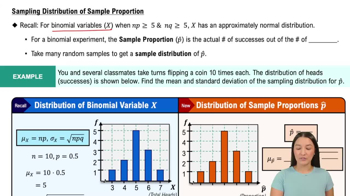Histogram of Interarrival Times Construct the histogram that corresponds to the frequency distribution from Exercise 1. Use class midpoint values for the horizontal scale. Does the histogram suggest that the data are from a population having a normal distribution? Why or why not?
Table of contents
- 1. Intro to Stats and Collecting Data1h 14m
- 2. Describing Data with Tables and Graphs1h 55m
- 3. Describing Data Numerically2h 5m
- 4. Probability2h 16m
- 5. Binomial Distribution & Discrete Random Variables3h 6m
- 6. Normal Distribution and Continuous Random Variables2h 11m
- 7. Sampling Distributions & Confidence Intervals: Mean3h 23m
- Sampling Distribution of the Sample Mean and Central Limit Theorem19m
- Distribution of Sample Mean - Excel23m
- Introduction to Confidence Intervals15m
- Confidence Intervals for Population Mean1h 18m
- Determining the Minimum Sample Size Required12m
- Finding Probabilities and T Critical Values - Excel28m
- Confidence Intervals for Population Means - Excel25m
- 8. Sampling Distributions & Confidence Intervals: Proportion1h 12m
- 9. Hypothesis Testing for One Sample3h 29m
- 10. Hypothesis Testing for Two Samples4h 50m
- Two Proportions1h 13m
- Two Proportions Hypothesis Test - Excel28m
- Two Means - Unknown, Unequal Variance1h 3m
- Two Means - Unknown Variances Hypothesis Test - Excel12m
- Two Means - Unknown, Equal Variance15m
- Two Means - Unknown, Equal Variances Hypothesis Test - Excel9m
- Two Means - Known Variance12m
- Two Means - Sigma Known Hypothesis Test - Excel21m
- Two Means - Matched Pairs (Dependent Samples)42m
- Matched Pairs Hypothesis Test - Excel12m
- 11. Correlation1h 6m
- 12. Regression1h 50m
- 13. Chi-Square Tests & Goodness of Fit1h 57m
- 14. ANOVA1h 57m
1. Intro to Stats and Collecting Data
Intro to Stats
Problem 1.1.10
Textbook Question
Determine whether the statement is true or false. If it is false, rewrite it as a true statement.
A sample statistic will not change from sample to sample.
 Verified step by step guidance
Verified step by step guidance1
Understand the concept of a sample statistic: A sample statistic is a numerical measure calculated from a sample of data, such as the sample mean, sample variance, or sample proportion. It is used to estimate the corresponding population parameter.
Recognize the variability of sample statistics: Sample statistics can vary from sample to sample because different samples may contain different data points, even if they are drawn from the same population. This variability is known as sampling variability.
Evaluate the given statement: The statement 'A sample statistic will not change from sample to sample' is false because sample statistics are subject to sampling variability and can differ depending on the specific sample selected.
Rewrite the statement as a true statement: A true version of the statement would be 'A sample statistic can change from sample to sample due to sampling variability.'
Conclude the reasoning: Sampling variability is a fundamental concept in statistics, and understanding it is crucial for interpreting sample statistics and making inferences about the population.
 Verified video answer for a similar problem:
Verified video answer for a similar problem:This video solution was recommended by our tutors as helpful for the problem above
Video duration:
4mPlay a video:
Was this helpful?
Key Concepts
Here are the essential concepts you must grasp in order to answer the question correctly.
Sample Statistic
A sample statistic is a numerical value calculated from a sample of data, which is used to estimate a population parameter. It can include measures such as the sample mean, median, or standard deviation. Since different samples can yield different values, sample statistics are inherently variable and can change from one sample to another.
Recommended video:

Sampling Distribution of Sample Proportion
Sampling Variability
Sampling variability refers to the natural variation that occurs when different samples are taken from the same population. Each sample may produce different statistics due to random chance, leading to different estimates of the population parameters. Understanding this concept is crucial for interpreting the results of statistical analyses and for making inferences about the population.
Recommended video:

Sampling Distribution of Sample Proportion
True Statement Revision
When a statement is found to be false, it is important to revise it to reflect the correct understanding. In this case, the false statement can be rewritten to indicate that a sample statistic can change from sample to sample, highlighting the concept of sampling variability. This revision helps clarify the nature of statistical estimates and their dependence on the specific samples drawn.
Recommended video:
Guided course

Step 1: Write Hypotheses

 2:13m
2:13mWatch next
Master Introduction to Statistics Channel with a bite sized video explanation from Patrick
Start learningRelated Videos
Related Practice
Textbook Question
1
views
